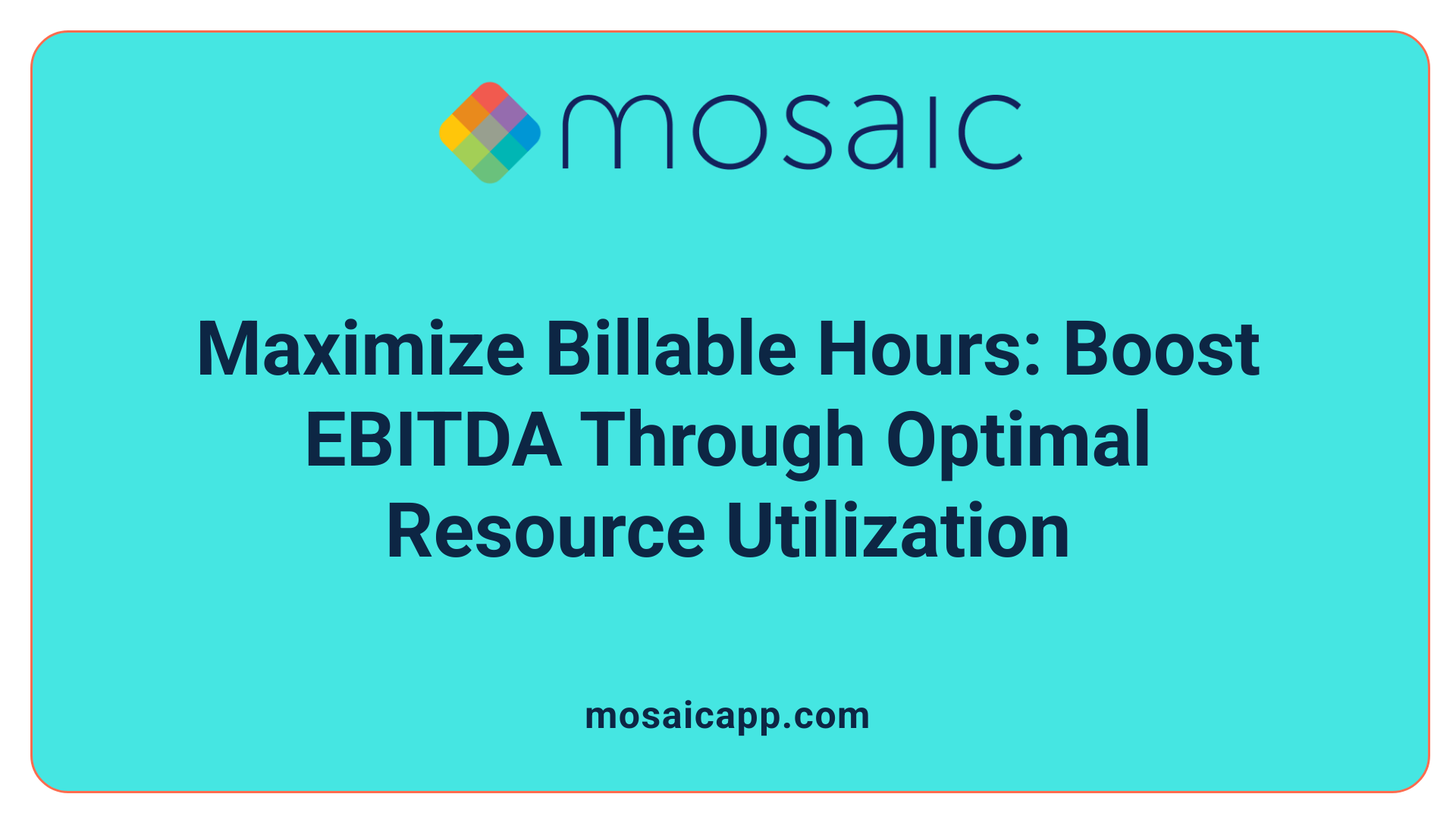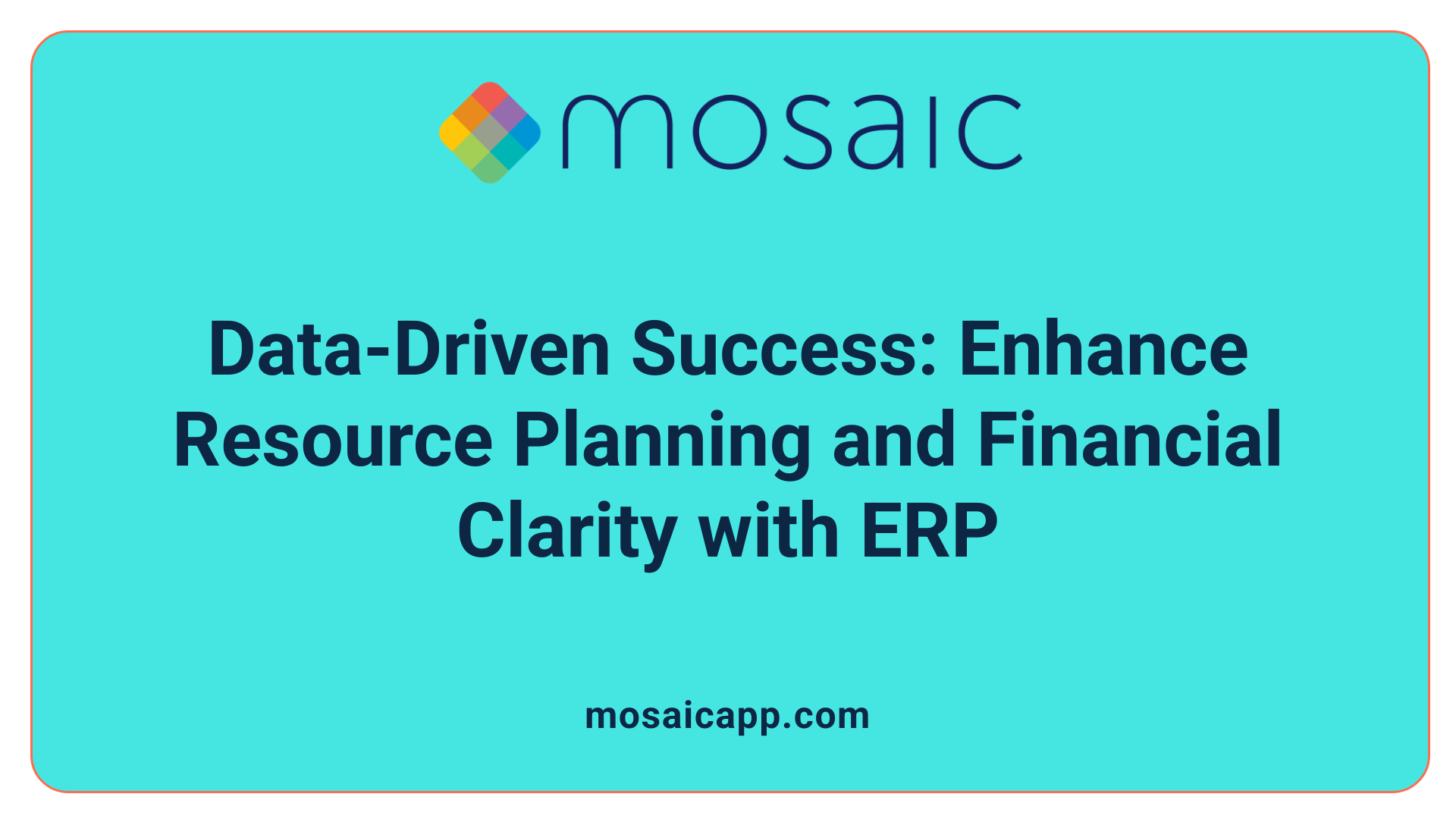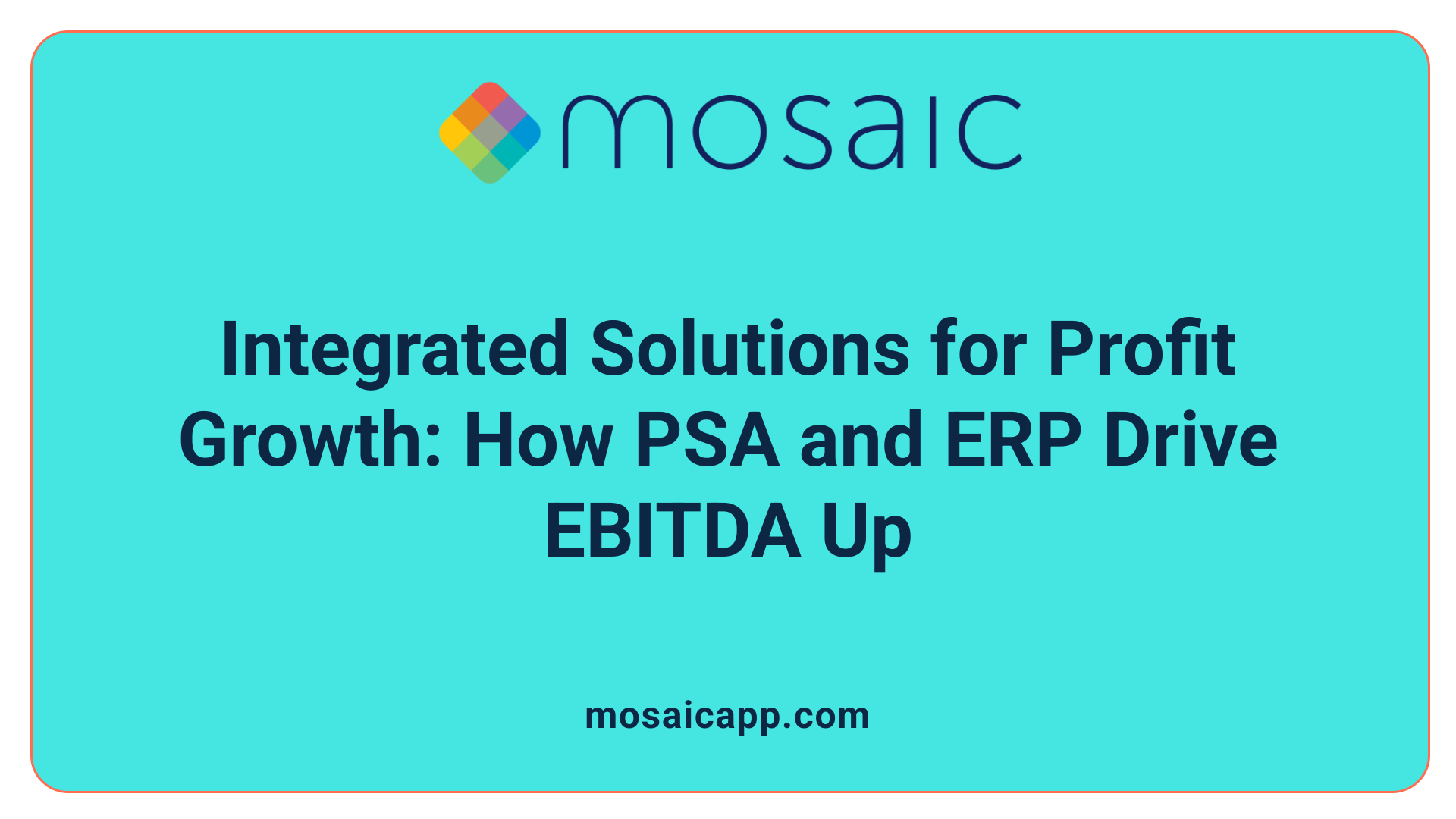Why Project Utilization Matters for Firmwide Financial Performance
In professional services firms, the strategic management of project resources is more than just an operational necessity—it's a critical driver of EBITDA growth and overall profitability. This article explores how effective resource utilization, enabled by advanced ERP and PSA technologies, directly correlates with enhanced financial metrics and sustainable firmwide success.
The Link Between Resource Utilization and EBITDA in Professional Services

How Does Employee Utilization Affect EBITDA?
Employee utilization represents the percentage of available working hours that employees dedicate to billable projects. Maximizing this utilization is crucial for professional services firms seeking to enhance their operating margin and EBITDA (Earnings Before Interest, Taxes, Depreciation, and Amortization). Higher utilization rates mean more hours billed, thereby increasing revenue without proportionally raising fixed costs.
Why Are Billable Hours Critical to Profitability?
Billable hours are the hours spent performing work directly charged to clients. These hours form the backbone of revenue generation for professional service firms. When firms successfully increase billable utilization rates, they not only boost top-line revenue but also improve profitability, as overhead and fixed staff costs remain relatively stable. Conversely, high non-billable time can dilute profits due to underutilized capacity.
What Does Empirical Data Reveal About Utilization Benefits?
Empirical research and case studies show a positive correlation between billable employee utilization and EBITDA growth. Firms that improve employee utilization rates have demonstrated significant net profit increases. For example, organizations leveraging integrated Professional Services Automation (PSA) tools experience up to a 32% EBITDA improvement by optimizing resource allocation and project delivery.
By monitoring and targeting higher billable utilization through cloud-based ERP platforms and robust analytics, firms not only enhance operational efficiency but also realize better financial outcomes. This alignment between utilization management and profit performance underscores its strategic importance in professional services.
Leveraging ERP Systems for Enhanced Resource Planning and Financial Insight

What is the role of cloud-based ERP platforms in resource and financial management?
Cloud-based ERP platforms have transformed how professional services firms monitor and improve EBITDA by integrating financial and operational data into a single system. Compared to legacy systems, these platforms provide real-time access to crucial metrics, enabling firms to track employee utilization, project progress, and profitability faster and more accurately. This holistic visibility supports informed decisions about resource deployment and financial health.
How does integration of financial and HR data enhance resource visibility?
Integrating financial with HR data within ERP systems gives firms a clearer picture of resource allocation and utilization. This consolidation helps identify under- or over-utilized employees, optimize billable hours, and forecast capacity needs. Better visibility increases the accuracy of profitability analysis by linking staffing levels and project costs, which directly contributes to improving EBITDA.
How does automation in ERP improve reporting efficiency?
Automation capabilities in modern ERP solutions drastically reduce the manual effort needed for financial and operational reporting. Automated data collection and analytics allow firms to quickly generate reports on revenue, margins, and resource utilization. This freed-up time enables finance and management teams to focus on strategic initiatives to boost EBITDA rather than just compiling data.
Together, cloud-based ERP systems that integrate comprehensive financial and HR data with automation tools empower professional service firms to optimize resource planning. This optimization results in improved project execution, maximized employee utilization, and ultimately stronger EBITDA performance.
Optimizing Talent Management to Support Project Utilization and Profitability
Talent Management Modules in ERP
ERP systems equipped with talent management modules play a crucial role in enhancing employee engagement and productivity. These modules enable firms to track skills, manage training, and align workforce capabilities with project requirements, ensuring optimal resource allocation within professional services.
Employee Satisfaction's Indirect Effect on EBITDA
Higher employee satisfaction, fostered by effective talent management, leads to increased productivity and retention. This reduces turnover costs and maintains project continuity, ultimately contributing to EBITDA growth through sustained billable utilization and fewer disruptions.
Balancing Workload to Prevent Burnout
Balancing employee workloads is essential to prevent burnout and disengagement. Proper workload distribution maintains motivation and reduces absenteeism, supporting a stable and efficient workforce that directly impacts project delivery quality and profitability.
By leveraging ERP-supported talent management, firms can enhance employee satisfaction and utilization rates, which together strengthen profitability and EBITDA performance.
Driving EBITDA Growth Through Integrated Project and Resource Management Software

What Are the Benefits of PSA Integration?
Professional services firms benefit significantly from integrating Professional Services Automation (PSA) software with their existing Enterprise Resource Planning (ERP) systems. This integration consolidates financial and human resource data, enhancing visibility into resource allocation and utilization. PSA tools streamline employee deployment, project tracking, and financial monitoring, enabling real-time decision-making and better resource planning.
Automation features within PSA and ERP platforms reduce manual reporting efforts, allowing firms to focus strategic initiatives on improving EBITDA. Enhanced analytics deliver insights into revenue, margins, and profitability, empowering organizations to optimize billable hours and improve workforce productivity while balancing employee workloads to prevent burnout.
How Does PSA Improve Project Outcomes and Profitability?
By applying structured project lifecycle management — covering initiation through closure — PSA solutions drive consistent project delivery aligned with strategic goals. Resource management is enhanced through scenario planning and configurable workflows, mitigating common planning blockers like timeline drifts and priority changes.
Effective resource utilization ensures projects are completed on time and within budget, reducing delays and scope creep. The real-time visibility into resource capacity allows firms to proactively manage bottlenecks and share resources across teams, which increases efficiency and client satisfaction. As project efficiency improves, so do profit margins, with best practice project management reportedly saving 28 times more money.
What Do Case Studies Reveal About EBITDA Increases from PSA Use?
Empirical evidence supports a strong link between PSA software use and financial performance. Organizations utilizing integrated PSA systems have reported an average EBITDA increase of 32%. Notable examples include Siemens Energy and Cisco, which demonstrated enhanced predictability, reduced planning time, and greater resource visibility across projects through PSA adoption.
These improvements in resource optimization and project execution directly support meeting strategic business objectives and accelerate EBITDA growth. Combined with integrated analytics and automation tools, PSA drives profitability by maximizing billable employee utilization and improving project delivery outcomes.
Best Practices in Resource Planning to Overcome Common Project Challenges
Addressing Resource Conflicts and Priority Changes
Resource conflicts, shifting priorities, and communication breakdowns are major barriers to efficient project execution. To tackle these, firms must adopt proactive resource management strategies. This includes establishing clear workflows and roles, as well as using integrated project and resource management software that offers visibility into competing demands and available capacity.
Real-time Tracking and Automation
Utilizing real-time progress tracking tools embedded within ERP or PSA solutions provides immediate insights into resource utilization and project status. Automation reduces manual effort by streamlining routine scheduling and updates, allowing teams to react swiftly to emerging issues. This improves agility in adjusting resource assignments and prevents timeline drifts.
Skill Gap Management and Data-driven Decision-making
Upskilling teams to fill critical skill gaps is essential for maintaining project momentum. Leveraging historical project data and predictive analytics supports informed decision-making, helping anticipate constraints and allocate resources optimally. Stress testing assumptions with scenario planning further strengthens preparedness against uncertainties.
Together, these best practices enable organizations to mitigate common resource planning challenges effectively, enhancing project delivery, client satisfaction, and profitability.
Utilization Metrics: Measuring Productivity and Driving Strategic Actions
What Are Utilization Rates and How Are They Calculated?
Utilization rates measure the proportion of available working hours that employees spend on productive, billable work. The basic formula to calculate overall resource utilization rate is:
[ \text{Utilization Rate} = \left( \frac{\text{Total Billable Hours}}{\text{Total Available Working Hours}} \right) \times 100 ]
This percentage helps firms assess employee productivity and operational efficiency.
Billable Versus Non-Billable Utilization
Billable utilization specifically tracks hours devoted to client-billable projects relative to potential billable hours, providing a precise gauge for billing and pricing accuracy. Conversely, non-billable utilization captures time spent on essential internal tasks such as training, administration, or business development. Balancing these two rates ensures workload fairness and employee wellbeing, preventing burnout and disengagement.
Leveraging Utilization Metrics for Business Success
Accurate tracking of utilization rates enables firms to optimize resource allocation, prioritize projects effectively, and improve pricing strategies by reflecting true employee effort. Enhanced utilization visibility also supports maximizing return on investment, strengthening collaboration across teams, and ultimately boosting firm profitability. By monitoring these metrics, professional services organizations can make informed strategic decisions that drive better project outcomes and EBITDA growth.
Technological Innovations Fueling Resource Efficiency and Predictability

How do scenario planning and configurable workflows enhance resource allocation?
Scenario planning enables firms to model different project outcomes and resource demands in advance. By anticipating potential challenges and opportunities, organizations can allocate resources more effectively and adjust plans proactively. Configurable workflows allow customization of processes to fit unique project needs, automating task assignments and approval paths, which reduces manual errors and accelerates project delivery.
What lessons do Siemens Energy and Cisco provide on using project resource management software?
Siemens Energy and Cisco illustrate the tangible benefits of adopting advanced project resource management tools. Both companies improved predictability of project outcomes, significantly reduced time spent on manual planning, and achieved greater transparency in resource allocation across multiple projects. These improvements led to smoother project execution and better financial performance by minimizing delays and optimizing resource utilization.
How does enhanced visibility contribute to preventing bottlenecks?
Real-time visibility into resource loads and capacity enables managers to identify potential bottlenecks before they occur. This insight helps in redistributing workloads, adjusting timelines, and reallocating personnel efficiently. As a result, projects run more smoothly, avoiding costly delays and scope creep, which directly supports improved profitability and EBITDA growth.
Project Resource Management’s Broader Influence on Business Performance and EBITDA

How Does Project Resource Management Impact Strategic Objective Fulfillment?
Effective project resource management plays a vital role in helping organizations meet their strategic goals. By ensuring that adequate people, equipment, materials, time, and money are allocated to projects, firms can complete initiatives on schedule and aligned with business priorities. Tools like scenario planning and configurable workflows within project management software enhance visibility into resource capacity and support proactive decision-making. This real-time insight helps prevent bottlenecks and resource conflicts, ultimately boosting project success rates and contributing to overall organizational performance.
How Does Resource Allocation Contribute to Cost Control?
Proper management and allocation of resources directly helps reduce delays, scope creep, and project failures, which are major drivers of unexpected costs. Automation capabilities in modern ERP and Professional Services Automation (PSA) solutions reduce manual effort in planning, allowing firms to focus on optimizing resource deployment to minimize waste. Additionally, balancing workloads prevents burnout and disengagement, reducing costs related to turnover. These efficiencies in managing resources not only control costs but also improve project delivery quality and client satisfaction.
What is the Relationship Between Resource Management and Firm-Wide Profit Margins?
Data shows a strong correlation between optimized resource utilization and improved financial outcomes. For instance, organizations employing integrated PSA software have reported up to a 32% increase in EBITDA, showcasing how enhanced resource planning translates to higher profitability. By maximizing billable hours and improving employee productivity, firms can increase revenue while controlling expenses. Moreover, best practice project management—such as monitoring phases from initiation to closure—can save as much as 28 times the cost, reflecting significant profit margin enhancements. Together, these elements demonstrate that efficient project resource management is foundational to boosting firm-wide profitability and sustaining growth.
Strengthening EBITDA Through Deliberate Resource Utilization Strategy
Optimizing project resource utilization stands out as a strategic lever for boosting firmwide EBITDA. By embracing integrated ERP and PSA technologies, professional services firms gain vital real-time insights and automation tools that facilitate superior planning, resource allocation, and talent management. These capabilities not only enhance operational efficiency and employee satisfaction but also translate directly into improved profitability and sustainable growth. Ultimately, firms that invest in disciplined resource management and leverage cutting-edge technological solutions position themselves for greater market competitiveness and long-term financial success.
References
- Why is EBITDA important to monitor, and how can ...
- The Relationship Between Utilization and Profitability in ...
- Project Management and Project Lifecycle Optimization
- Resource Planning in Project Management: Boost ...
- The Importance of Resource Utilization in Project ...
- How Project Resource Management Can Boost Your ...


